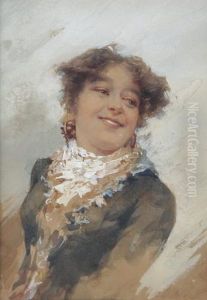Angelo Comolli Paintings
Angelo Comolli was an Italian painter, born in 1745 in Rome, Italy. He was an artist whose life and career were relatively short, with his death occurring in 1796 at the age of 51. Not much is widely known about Comolli's personal life, and he remains a somewhat obscure figure in the broader spectrum of art history. However, he was active during a period that was rich with artistic development and innovation, particularly in Rome, which was a hub for artists during the 18th century.
Comolli's work is often characterized by its engagement with the themes and styles prevalent in the late Baroque and early Neoclassical periods. During his lifetime, the Neoclassical movement was beginning to take hold, which emphasized a return to the simplicity and grandeur of ancient Greek and Roman art. This influence is noticeable in the classicizing elements present in his work, with a focus on harmony, balance, and a subdued palette.
Despite his relative obscurity, Comolli contributed to the artistic scene of his time. He produced paintings and frescoes for various churches and buildings in Italy. His style was in line with the transition that was occurring in art during his lifetime, although he did not achieve the same level of fame as some of his contemporaries, such as Jacques-Louis David or Antonio Canova.
Comolli's legacy, while modest, is preserved in the works that survive him. These pieces are important for understanding the evolution of artistic styles and preferences during the transition from the Baroque to Neoclassicism. They also provide insight into the local artistic practices in Rome during the second half of the 18th century. Unfortunately, details about his training, patrons, and influence on his peers are scarce, making it difficult to fully assess his impact on the art world. Nevertheless, for those interested in the period, Angelo Comolli remains a figure worthy of recognition and study, representing the often-overlooked artists who contributed to the rich tapestry of art history.




